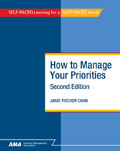How to Manage Your Priorities, Second Edition
Author: Janis Fischer Chan
Credit: 1.0 CEUs
Testing Format: multiple choice
Your Price: $139.00
ISBN: 9780761214649
Format: Book
Overview
The latest tools and techniques for accomplishing more in less time with fewer resources.
In today’s competitive global environment—where people at all levels need to accomplish more, in less time, with fewer resources—the ability to manage priorities is a key element in personal and professional success. How to Manage Your Priorities, Second Edition, provides managers, team leaders, professionals, and others in the workplace with the tools to master this essential business skill.
The second edition, revised and updated with a new chapter on technology-based tools for identifying and organizing priorities, teaches managers the critical benefits of managing their priorities and removing the obstacles that interfere with success.
Course Objective: Acquire strategies to identify and manage key priorities, achieve objectives, improve the quality of work and reduce stress
Selected Learning Objectives
• Identify what’s important
• Accomplish more in less time, with fewer resources
• Manage your workload to improve your working relationships
• Organize a task or project so outcomes meet expectations and objectives
• Collaborate with others to make sure deadlines are necessary and reasonable
• Improve the quality of your work and reduce stress
• Master key strategies for prioritizing tasks and activities
• Practice the best planning and scheduling techniques
• Use technology to manage your priorities: planning and scheduling tools, project management software, PDAs, organizing systems
Testing Format
This course contains one multiple choice test valued at one Continuing Education Unit (CEU).
Table of Contents
About This Course
How to Take This Course
Pre-Test
1. Why Learn to Manage Your Priorities? 1
What It Means to Manage Your Priorities
Why Learn to Manage Your Priorities?
The Benefits of Managing Your Priorities
More Productive Working Relationships
Better Outcomes and Fewer Time-consuming Mistakes
Improved Chances for Achieving Goals
Increased Productivity
Improved Work/Life Balance
Reduced Stress and Improved Health
What Gets in the Way?
Failure to Identify Clearly What Is Important
Vague Goals and Expected Outcomes
Lack of Planning
Poor Communication
Conflicting and/or Unexpected Needs and Demands
Failure to Recognize and Respond to Change
Lack of Resources
Striving for Perfection, Not for Results
Failure to Think Creatively
Organizational Problems
What You Will Learn in This Course
Recap
Review Questions
2. How to Know What Is Important 15
Why Focus on Goals?
Linking Goals and Priorities
Make Your Goals SMART Goals
Relating Tasks and Activities to Goals and Consequences
Consider Tasks and Activities in Terms of Goals
Consider Tasks and Activities in Terms of Consequences
Recognizing What Is Urgent and What Is Not
1. Urgent and Important
2. Not Urgent but Important
3. Urgent but Not Important
4. Not Urgent and Not Important
Recognizing What Activities Have Greater Value
Being Efficient Versus Being Effective
Recap
Review Questions
3. Strategies for Managing Your Priorities 33
Use a System
Focus on the Outcome and Clarify Expectations
Guidelines for Focusing on the Outcome and Clarifying Expectations
Evaluating Available Resources
Determine What You Can Stop Doing
Identify What No Longer Needs to Be Done
Delegate Work You Do Not Need to Do Yourself
Reduce Interruptions
Anticipate Problems
Manage Conflicting Priorities
Take Care of Yourself and Manage Stress
Warning Signs of Stress
How to Take Care of Yourself
Recap
Review Questions
4. Planning and Scheduling 51
What Action Planning and Scheduling Can Accomplish
Components of an Action Plan
What Is the Expected Outcome and What Is the Deadline?
What Activities Are Necessary to Achieve the Outcome?
What Resources Are Needed and Where Will They Come From?
Who Else Needs to Be Involved and What Is the Nature of Their Involvement?
What Factors Might Influence or Constrain the Way the Outcome Is Achieved?
What Is the Sequence of Key Activities and What Are the Progress Checkpoints?
Who Will Do What?
What Problems Might Come Up and What Will Be Done to Handle Them?
When Don’t You Need an Action Plan?
Scheduling
Realistically Estimate the Time Needed to Complete Each Task and Activity
Identify Activities that Can Be Clustered
Decide When You Do Your Best Thinking
Leave “Lag” Time in Your Schedule
Include Time for Thinking and Reflecting
Allocate Sufficient Time for “Important, Not Urgent” Activities as well as
“Urgent and Important” Activities
Build in Personal Time
Review and Revise Your Schedules Regularly
How to Build a Schedule
What If There Really Is Not Enough Time?
Recap
Review Questions
5. Working Efficiently 71
What It Means to Work Efficiently
Obstacles to Working Efficiently
Doing Things You Enjoy Instead of Those that Move You Towards Your Goals
Using E-Mail Unproductively
Unnecessary Interruptions
Disorganization
Managing by Crisis
Inefficient Delegation
Saying “Yes” to Everything
Unnecessary or Poorly Planned Meetings
Procrastination
Doing Things That Do Not Need to Be Done
Tracking Your Time Wasters
Strategies for Working More Efficiently
Decide What You Can Stop Doing
Reduce Interruptions
Check Your E-Mail on a Schedule
Reflect on Your Day Before It Begins
Revise Your Priorities, If Necessary
Seek Help
Keep Up with Routine Work
Delegating Successfully
Tips for Delegating Work
Using E-Mail Productively
Tips for Using E-Mail Productively
Recap
Review Questions
6. Using Technology to Manage Your Priorities 91
Tools to Help You Manage Your Priorities
Computer Applications for Organizing and Scheduling
Computer Applications for Managing Your Goals and Projects
Tools for Working Remotely
Personal Digital Assistant (PDA)
Teleconferencing System
Instant Messaging (IM)
Text Messaging
Palm Pilot
BlackBerry
Pocket PC
Personal Information Manager (PIM)
Short Message Service (SMS)
Common Problems When Using Technology-Based Tools
Reducing Technology-Based Problems
How to Learn More About Technology-Based Tools
Recap
Review Questions
Bibliography
Post-Test
Index

